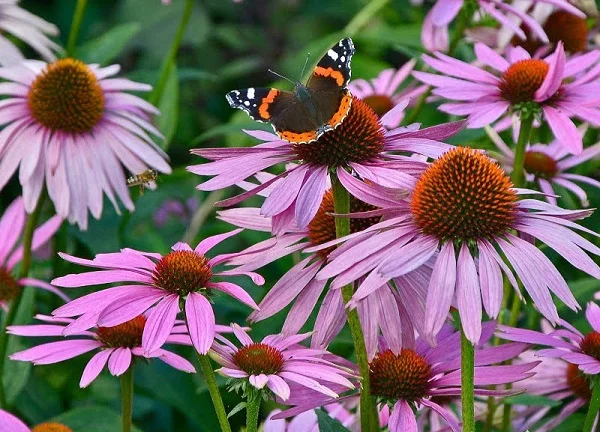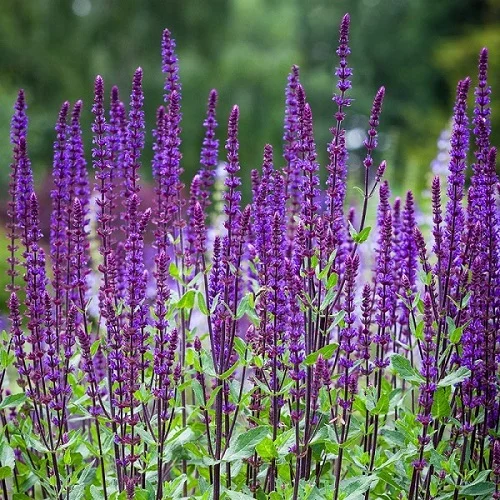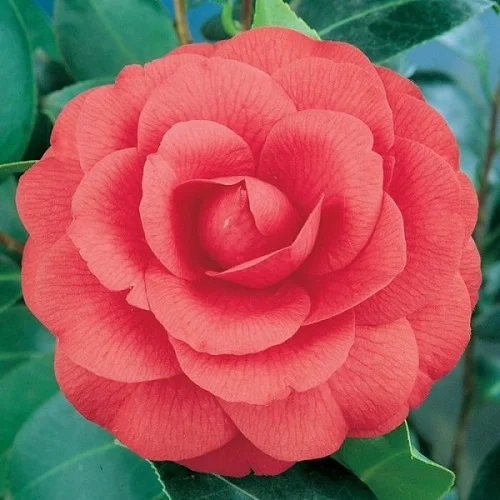How to Grow and Care for Common Lantana | Lantana camara Care Guide
Some links in this post may be affiliate links
Lantana camara or Common Lantana is a perennial, erect, sprawling shrub and a fast-growing, prolific bloomer which blooms through out the year in tropical climates.
The leaves are broadly ovate, opposite and simple, serrated (toothed), rough to the touch and have a strong citrusy smell when crushed. The young stems and branches are angular, hairy and bear curved spines along the edges. When they mature, they become round and gray and brown in color.
Common Lantana is a frost-tender plant which grows best in the warm tropical climates as a perennial shrub. It is hardy in USDA Hardiness Zones 9-11 where it can be grown as a perennial garden plant.
In the colder climates, Lantana camara is grown as an annual garden plant which is left to die in the winter and replanted in spring or it can be grown in containers which can be brought inside in winter and placed in a cool place with minimal light and water to keep it dormant.
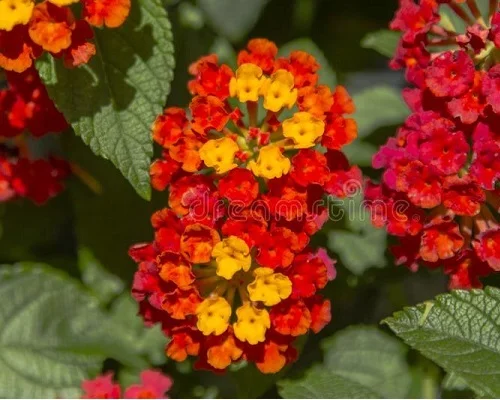
Image Credit: Dreamstime.com
Botanical name: Lantana camara
Family: Verbenaceae
Common names: Common Lantana, Shrub Verbena, Wild Sage, Tick Berry
Origin
Lantana camara is native to Central and South America. It has been naturalized in many parts of the world like Asia and Oceania.
Size
Common Lantana can grow to a height of 6 feet and the same spread.
Flowers
Common Lantana flowers are small, tubular-shaped and arranged in clusters in terminal areas of the stem. They have a tutti fruiti smell with a pepery undertone and come in red, yellow and orange. Many hybrids have been developed which come in many colors, even mixed ones.
Shrub Verbena blooms in summer to late fall in the cold climates but can bloom through out the year in frost-free climates. The flowers attract humming birds, butterflies and other pollinators.
The pollinated flower develops into a berry-like drupe which turns from green to dark-purple when it matures. Each plant can produce upto 12000 fruits.
Lantana camara Varieties
Numerous varieties (cultivars) of Lantana camara have been developed which can exhibit mounding, spreading and trailing growth habits. Some of these include;
Miss Huff which is a sterile, upright, mounding, cold-hardy variety and grows 6 feet tall. It bears flowers in shades of coral, gold and orange.
Mozelle which is a sterile, upright, mounding, cold-hardy cultivar and bears flowers in light pastels of shades of pink and yellow.
Gold Mountain which is a very hardy, spreading, profuse bloomer. It grows 2 feet high and 4 feet wide. The blooms are deep gold.
Athens Rose is a 3 feet tall, upright, mounding cultivar which bears magneta flowerbuds which open to yellow and deep-pink blooms.
Patriot Desert Sunset which is a 3 feet high, sterile, upright, mounding cultivar which bears coral, pink. gold or orange flowers.
Patriot Honeylove which is a 2 feet high and 2 feet wide, mounding cultivar with gently drooping limbs perfect for a hanging basket. It bears flowers in pastel shades of Ivory, yellow and pink.
Clear White which is a low spreading cultivar which bears white blooms.
Cape Hill Gold which is a 1 foot high and 3 feet wide, low-growing, spreading, col-hardy cultivar which bears golden-yellow blooms.
Lantana camara Medicinal Uses
Lantana camara leaves have an antimicrobual, fungicidal and insecticidal properties according to Studies done in India. The leaves have been used in traditional herbal medicine to treat asthma, cancer, chicken pox, leprosy, measles, ulcers and skin irritation.
Lantana camara Invasiveness
Common Lantana is a very hardy and adapatable species which spreads rapidly and has become an invasive weed in many warm climates in the Pacific Regions, Australia, India and East Africa (Kenya, Uganda, Tanzania). It excretes allelopathic chemicals which reduce growth of surrounding plants by preventing germination and root elongation.
Lantana camara Toxicity
Lantana camara has several side effects to human and animal health. The plant contains pentacyclic triterpenoids (Lantanadenes). If ingested, these chemicals can cause vomiting, diarrhea, dificult breathing, damage to the liver and photosensitivity in humans and animals as stated on the website of North Carolina State University Extension Gardener.
The unripe fruits are inedible to humans and animals as the dense patches of hard spikes on the rind can cause serious damage to the digestive system if ingested. Some studies have claimed that the ripe fruits are edible and cause no harm if ingested.
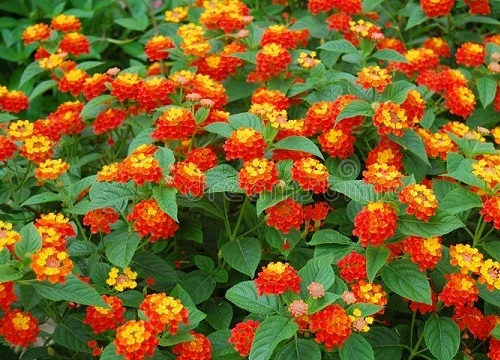
Image Credit: Dreamstime.com
Lantana camara Care
Common Lantana (Lantana camara) thrives in full sun with at least 6-8 hours of sunshine per day, warmth of 12-300C, average humidity and consistently moist, neutral soil that is well-drained coupled with one feeding in the growing season.
Lantana camara requires deadheading of the spent flowers to keep the plant neat and to minimize pest and disease infestations as it improves aeration. Annual cutting back is necessary to encourage new growth and promote flowering. Keep reading for more on these growing conditions and how to provide them.
Light Requirements
Common Lantana requires full sun with at least 6-8 hours of sunshine per day through out the growing season and minimal light in winter for the container-grown plants to keep them dormant.
Avoid shaded conditions where the plant will be overshadowed by tall buildings, trees or other large plants as they require full sun for the production of flowers.
Water Requirements
Water Common Lantana deeply and keep the soil consistently moist during the growing season for the young plants. To achieve this, water again when the top 1-2 inches of soil dry out. Mature plants are drought-tolerant and do not require much water.
For container-grown Tick Berry, ensure that the pot has a drainage hole and the soil is fast-draining to prevent the plant from sitting in soggy soil which can result in rotting and death of the plant. Decrease watering in the cold period as growth is reduced at this time, thus, the plant does not need much water for growth.
Temperature and Humidity
Common Lantana requires average temperatures within the range of 12-300C to thrive and bloom. In winter, the plant is dormant. To keep the soil warm in winter, apply a mulch of dry vegetation on the soil surface but take care not to let the mulch come into contact with the stem to prevent rotting.
Container-grown Shrub Verbena should be brought indoors when the temperatures dip to -20C and positioned in a cool place with minimal light and water to keep it dormant.
Fertilizer
Common Lantana is not a heavy feeder, therefore, regular feeding is not needed. It should only be fertilized once in spring for the plants in the ground.
Container-grown Shrub Verbena can be fed monthly with a balanced, water-soluble fertilizer during the growing season but do not feed in the cold season to avoid fertilizer burn as growth is minimal. Take care not to overfeed as it can lower flower production, yellow leaves and leaf drop.
Soil
The best soil for Common Lantana should be well-drained and at a PH of 6-8; use a soil PH meter to ascertain it is within this range. If the PH is not within the recommended range, it should be ammended. To increase PH (if it is too acidic), add lime to the soil. To decrease PH (if it is too alkaline), add soil sulphur. Allow a 2 weeks period for the soil to correct the PH.
Where to Buy Lantana camara
Common Lantana Plants are available from Garden Centres at the beginning of spring. You may acquire these plants from Etsy (Link to Etsy).
When to Plant Lantana camara in the Ground
The best time to plant Common Lantana in the ground is in spring for both perennial and annual plants.
Planting Lantana camara in the Ground
Dig up the soil to loosen it and get rid of all the weeds and other debris from the soil. Make sure that the soil is well-drained.
Prepare planting holes slightly wider than the rootballs at a spacing of 3-4 feet. Incorporate a handful of fully decomposed organic manure per hole.
Plant the Shrub Verbena at the same depth as they were in their pot. Firm the soil around the root ball lightly.
Thoroughly water the plants and keep the soil until the plants are established. Thereafter, water when the top 2-3 inches of soil dry out during the growing season but decrease watering in the cold season.
Repotting Container Grown Lantana camara
Where the conditions are not favourable for growing Common Lantana in the ground like in areas with harsh winters, you can grow the plant in containers.
Doing so allows you to move the plants to sunny spots during summer for the much needed sunlight and indoors in a cool place with minimal light when the conditions are harsh in winter.
Repot Tick Berry every 2-3 years at the beginning of the growing season (spring). Use a pot that is 2 sizes larger than the current one to provide adequate room for growth.
Make sure that the container(s) or pot(s) has a drainage hole to prevent the soil from getting soggy to prevent root-rot and eventual loss of the plant(s).
Slip the Common Lantana out of its pot, reduce the roots by third and place it in the center of the new pot. Back fill with fresh, free-draining soil at the same soil level as it was in the previous pot.
Do not fill the pot completely but allow a space of about 1 in. from the rim for watering purposes to avoid spillage.
Wet the soil thoroughly until water comes out through the drainage hole(s). Thereafter, water thoroughly during the growing season (summer) when the top 2-3 inches of soil dry out. Reduce watering in the cold season (winter).
Pruning Lantana camara
Pruning Common Lantana involves cutting back the plants in spring to 6-12 inches above the ground to encourage branching and blooming. Cutting back promotes new growth and controls the size of the plant.
After cutting back, water deeply and fertilize the plant to envourage vigorous growth and to keep it blooming.
Do not cutback the plant in fall as it reduces the ability of the plant to withstand the cold in winter.
Deadhead spent flower if seeds are not required to keep the plant neat and tidy and also discourage pest and disease infestations.
Common Lantana is self-seeding, therefore, to contain it and keep it from growing where it is not needed, deadheading is a recommended practice.
Overwintering Lantana camara
Common Lantana is a grown as perennial plant in the warm climates or annual in the cold regions. Where the plant is grown as a tender perennial in the cold regions, it can be grown in containers which are brought indoors when the temperatures dip to -20C.
If the plant is planted in the ground, it can be dug up and planted in pots. The pots can then placed in a cool place with minimal light and water to keep them dormant in winter.
These plants can then be planted outdoors in spring when the temperatures warm up and routine care can begin.
Lantana camara Uses
Common Lantana can be used as border shrubs, ground covers and hedge plants in warm climates and hanging baskets or potted plants for a patio, deck, balcony or terrace in cold climates.
Propagation
Common Lantana (Lantana camara) is easily propagated from seeds, stem cuttings and divsion at the beginning of the growing season (spring or early summer) when new growth has begun.
Starting Lantana camara Seeds
Common Lantana seeds should be started indoors at least 6-8 weeks before transplanting. You can buy the seeds from the stockists or you can harvest the same from your plants.
To obtain the seeds from your plants, harvest the pods when the turn dark-purple. Remove the seeds from the pods, wash with water and dry them on a towel for a few days.
Store the dried seeds in dry container and place it in the refrigerator until you are ready to sow them.
When you are ready to germinate, soak the seeds in warm water one day (24 hours) before sowing.
Sow each seed in the center of a small pot (about 4 inch wide) in well-drained seed starting soil and lightly cover with soil.
Cover the pot with a clear plastic bag to create a greehouse effect (increase humidity and warmth) inorder to fasten germination.
Place the set up in a well-lit, warm (about 150C) place away from direct sunlight.
Maintain the soil slightly moist until the seeds are germinated. Germination should occur in about 4 weeks.
Once germinated, remove the plastic cover and allow the plants to be well established before transplanting outdoors.
Transplant the new Shrub Verbena outdoors in spring (beginning of the growing season) when the temperatures begin to warm up.
How to propagate Lantana camara from stem cuttings
Take 3-5 inches stem cuttings from a healthy Common Lantana by cutting just below a leaf node.
Strip off the leaves from the lower 2-3 inches of the stem and dip the lower end in a rooting hormone to hasten rooting.
Insert the cutting in moist, free-draining, rooting soil in a small pot (about 4 in. wide) and lightly firm the soil around the cutting.
Cover the set up with a clear plastic bag to create a greehouse effect (increase humidity and warmth) to fasten rooting.
Place the set up in a well-lit, warm (about 150C) place away from direct sunlight to avoid cooking the plants.
Maintain the soil slightly moist until the stem cuttings have rooted. Rooting may take 4-6 weeks and is indicated by growth of new leaves.
Tug at the cuttings a little, any resistance indicates rooting has occurred. Once rooted, remove the plastic cover.
Place the pots in a sunny spot and maintain the soil moist through out until the plants are well established. Transplant the new Tick Berry outdoors at the beginning of the growing season (spring).
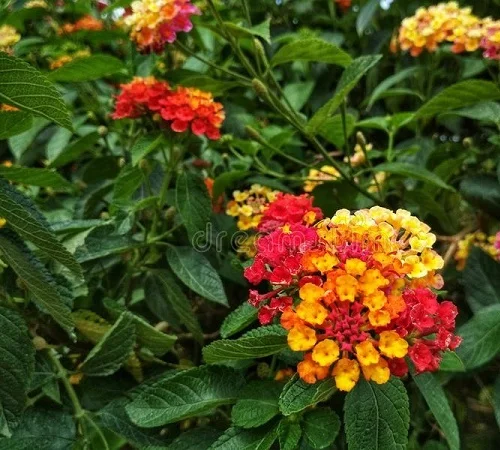
Image Credit: Dreamstime.com
Lantana camara Growing Problems
Common Lantana (Lantana camara) is hardy plant which has few growing problems if the growing requirements are met. However weak plants can be attacked by diseases and pests. Keep reading for more on these problems and how to fix them.
Diseases
Common Lantana is prone to root-rot disease which is prevalent in soggy soil brought about by poorly drained soil. Ensure that the soil is loose and free-draining.
For the potted plants, ensure that the pot has a drainage hole and always empty the catch plate a few minutes after watering to avoid getting soggy soil. Do not let the plant sit on the excess water for too long.
Shrub Verbena is also prone to powdery mildew which is common in overdamp, poorly ventillated conditions. Avoid wetting the foliage during watering and apply the water at the soil surface. Ensure proper pruning to improve air circulation. Where the infestation is heavy, spray the plant with a fungicidal solution as recommended by the manufacturers.
Pests
Common pests in Lantana camara are aphids, spider mites, whiteflies, mealybugs and lacebugs. Be on the look out for these pests and take timely control measures to arrest damage. Spray the plant with an insecticidal soap or neem oil to get rid of the pests. Make sure to follow the manufacturer's instructions.
You liked it? Share on social media.
Related Content
Amazon Associates Disclosure
Homeplantsguide.com is a participant in the Amazon Services LLC Associates Program, an affiliate advertising program designed to provide a means for sites to earn advertising fees by advertising and linking to amazon.com.
